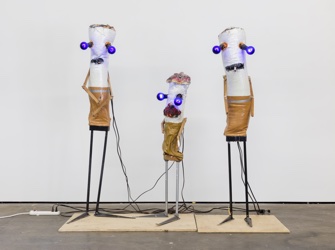
After a couple of years of dormancy, the Mona Bismarck American Center has come back to life under its new artistic director, Raina Lampkins-Fielder, who has inaugurated a rich program of events held in the Seine-side mansion of the eponymous American socialite who bequeathed her Paris home for the creation of a center for American art and culture in France.
The new director’s first major exhibition, “Wasteland: New Art from Los Angeles,” is being held in conjunction with the Pantin branch of the Galerie Thaddaeus Ropac, one of Paris’s top contemporary art galleries, and an association called LAND (Los Angeles Nomadic Division). The exhibition’s name, inspired by T.S. Eliot’s poem “The Waste Land,” raises the question of whether or not Los Angeles is a cultural wasteland and sets out to prove that it isn’t by presenting the work of 14 artists working in the city (without a single direct reference to Hollywood!).
Eliot’s poem is itself the subject of one of the works at the Ropac gallery, by Daniel Joseph Martinez; it consists simply of a wall label with an excerpt from Eliot’s poem, entitled “What the Thunder Said, 2015”: “Paris attacked by ISIS terrorists / After the torchlight red on sweaty faces / After the frosty silence in the gardens / After the agony in stony places / Prison and palace and reverberation / Of thunder of spring over distant mountains / He who was living is now dead / We who were living are now dying / With a little patience.” One of the lines from Eliot’s poem – “The shouting and the crying” – is missing, whether by intention or error is not clear.
Another work by Martinez refers rather enigmatically to another Paris event. Entitled “Death by Water 1968: Students at the Sorbonne University Protest and Riot, Paris. AGAINST STUPIDITY, 2015,” it consists of protest signs printed with the slogan “AGAINST STUPIDITY,” a sentiment unlikely to inspire counter-demonstrations. Visitors are free to take a sign with them, and something of a mini-demonstration formed in the courtyard of the Ropac gallery during the opening.
Martinez is also behind the two eye-catching black air dancers blowing in the wind outside the Ropac gallery (see this week’s Photo of the Week), which he calls “The Fire Sermon 1940 (Nazi Occupation of Paris).”
One of the more amusing yet disturbing works at Ropac is Jon Pylypchuk’s “the pack (i will always love you)” (pictured at the top of this page), with its three cigaratte-smoking, purple-lightbulb-eyed butt-shaped dolls. Pylypchuk must be either a fervent smoker or a heartbroken ex-smoker.
Evocative works by Ry Rocklen appear in both venues. At Ropac, a complex piece called “Father and Son” involves a photographic image of a faceless man in a suit printed on a ceramic form and broken up by glass shelves attached to a mirror. Other works by Rocklen at Mona Bismarck include two ceramic vases – entitled “Denain Grace” and “Toucan Man” – set on a mantelpiece facing a mirror, with distorted human faces on one side and photographic images on the other, flat side. The effect is intriguing and psychologically suggestive.
To fully appreciate this show, I highly recommend that you go to both venues. Getting to Ropac’s Pantin location is something of a trek, but it is worth it to see some of the better works from “Wasteland” and its fabulous spaces in former industrial buildings set around a courtyard. You can also catch two other great shows while you are there: monumental sculptures by Tony Cragg, whose work only gets more interesting with time, and black-and-white photos by the late actor Dennis Hopper that capture the spirit of the era and milieu he lived in, with powerful images of everyone from Paul Newman to Andy Warhol.
Galerie Thaddaeus Ropac: 69, Avenue du Général Leclerc, 93500 Pantin. Métro: Eglise de Pantin. RER E: Pantin. Tel.: 01 55 89 01 10. Open Tuesday-Saturday, 10am-7pm. ropac.net
Favorite